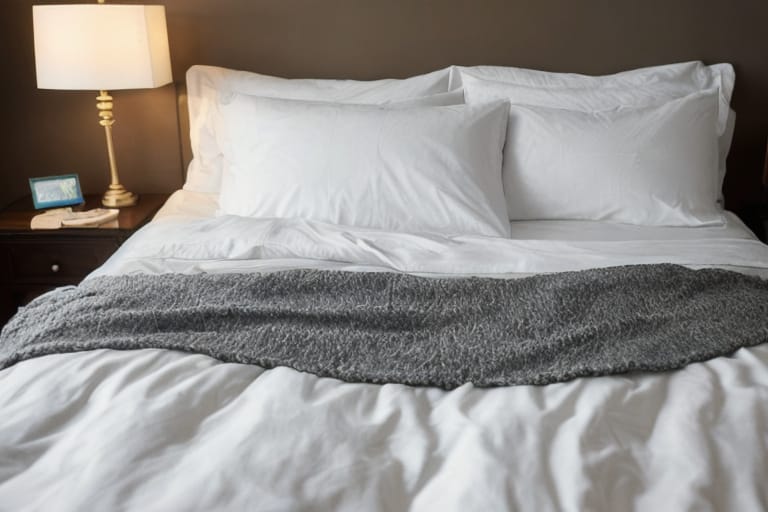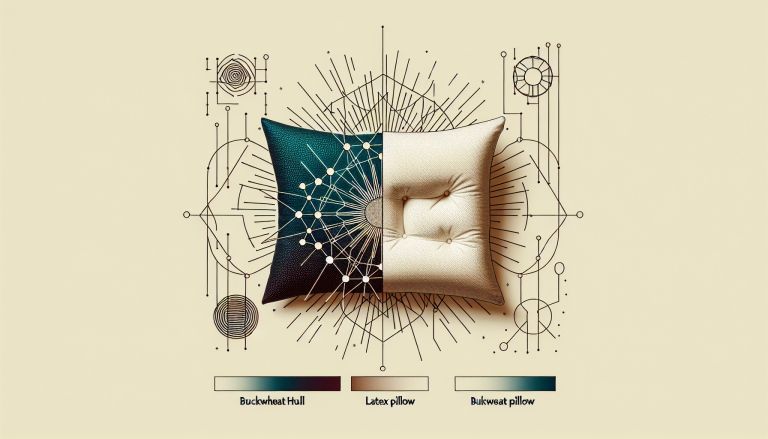Are you looking to add a cozy yet breathable comforter to your bed? Down alternative comforters provide warmth and softness without the high price tag and allergy concerns of regular down. Made with synthetic fills like polyester and PrimaLoft as well as natural fabrics like cotton and silk, these comforters strike the perfect balance between comfort and affordability.
What Are Down Alternative Comforters?
Down alternative comforters provide insulation and plushness similar to down-filled versions, but without feathers and at more budget-friendly price points. They are filled with synthetic fills like polyester, PrimaLoft and microfiber or natural fabrics like cotton, wool, and silk rather than duck or goose down.
The main advantages of choosing a down alternative comforter include:
- Hypoallergenic properties for allergy sufferers
- Affordability over regular down
- Good breathability for better temperature regulation
- Easy care and maintenance
Fill Materials Used in Down Alternatives
Synthetic Fills
Several types of synthetic fills are used to mimic the qualities of feather and down fills.
PrimaLoft
PrimaLoft is a popular, lightweight synthetic fill that resembles down. It provides good warmth and compression but is less breathable than natural fibers. PrimaLoft is also water-resistant and dries quickly.
Polyester
Polyester fill comforters are budget-friendly versions with decent insulating abilities. Low-quality polyester may not be as breathable. High-quality microfiber polyester offers better ventilation.
Microfiber
Microfiber fill, made of very fine polyester fibers, mimics the softness of down well while wicking away moisture. It can be washed more easily than down and is also quite affordable.
Natural Fabric Fills
Cotton
Cotton fill comforters with a percale cotton cover offer great air circulation and breathability. They provide moderate insulation for the spring and fall or warm environments.
Silk
Silk-filled comforters provide warmth while feeling extremely soft and smooth against the skin. Silk allows good temperature regulation but requires delicate care.
Wool
Wool-filled comforters offer impressive insulation in a lightweight package while being quite breathable. Wool naturally resists dust mites. It may feel slightly rough or irritating to sensitive skin though.
Properties of Down Alternatives
Breathability vs Insulation
The amount of insulation, or warmth, a down alternative comforter provides depends largely on the fill material and density. But adequate breathability is also key for temperature and moisture control.
Synthetic fills like PrimaLoft, microfiber or low-density polyester and natural fabrics like cotton and wool offer the best combinations of insulating ability and breathability.
Hypoallergenic Qualities
Down alternative comforters are naturally hypoallergenic as they contain no animal proteins that commonly trigger allergies in goose or duck down bedding.
Certain fill materials like PrimaLoft and microfiber polyester resist dust mites and allergens even better. Some comforters also receive special antimicrobial treatments to inhibit bacterial growth.
Durability and Longevity
The lifespan of a down alternative comforter depends primarily on the quality of materials and manufacturing. In general, with proper care, PrimaLoft and high-density microfiber or polyester comforters may last you around 5-10 years.
Cotton, wool and silk versions may show visible deterioration after 3-5 years. Overall, most down alternative options tend to be less durable than quality goose down comforters.
Construction Details That Matter
Clusters vs Stitched Sections
Down alternative comforters may feature clusters of fill scattered throughout or neatly stitched internal sections with filling distributed evenly.
Cluster construction mimics traditional down bedding better but can result in cold spots. Stitched sections provide more even warmth distribution.<div class=”table-container”>
| Construction Style | Pros | Cons |
|---|---|---|
| Clusters | More down-like appearance and texture | Can shift around causing cold and hot spots |
| Stitched Sections | Even fill distribution, fewer cold spots | Less “fluffy” feel |
Percale Cotton Shell and Thread Count
A smoother percale cotton makes the best shell or outer covering material for comforters instead of cheaper muslin cotton. Percale woven using finer threads allows enhanced airflow.
The thread count of the shell fabric also affects breathability. While a higher thread count may seem better, percale cotton with a count between 200-400 proves optimal. Higher counts can mean more condensed threads and less ventilation.

Comparative Analysis: Down vs Down Alternatives
How do down alternative comforters stack up against regular down bedding across important metrics?
Fill Power
Fill power measures the loft and insulation ability of down fills. Most down comforters offer fill power between 600-800. PrimaLoft and microfiber mimic these properties the closest among down alternative options.
Weight and Fluffiness
Alternative comforters, especially PrimaLoft models, come quite close to the billowy texture of down comforters. But they are typically heavier for their warmth ratings.<div class=”table-container”>
| Comforter Type | Fill Power | Weight for Warmth Rating | Fluffiness |
|---|---|---|---|
| Goose Down | Highest (600-800+) | Light | Maximum |
| PrimaLoft Down Alternative | High | Heavier | High |
| Polyester or Microfiber Down Alternative | Moderate | Heavier | Moderate |
| Cotton/Wool/Silk Down Alternative | Lower | Varies | Low-Moderate |
Longevity and Maintenance
Down comforters that are ethically sourced and well cared for can last over 10-20 years. With periodic upkeep, most synthetic and natural down alternatives last 5-10 years.
Cotton, wool and silk alternatives usually require more frequent washing to remove allergens though. PrimaLoft and microfiber versions allow easier, low-maintenance cleaning.
Temperature Regulation Ability
Factors Affecting Heat Retention
The fill power rating along with the fill weight or density determine how well a down alternative comforter retains heat. Choose options with the warmth level suited for your climate.
- Using lightweight, breathable shell fabrics like cotton percale also allows better ventilation and cooling.
- For hot sleepers, layers like blankets or mattress toppers can be removed easily to prevent overheating.
Preventing Night Sweats
Those who tend to sleep hot must pick comforters allowing adequate airflow, like cotton or wool versions. Moisture-wicking fills like PrimaLoft also help manage night sweats effectively.
In summer, use the comforter as a removable duvet by taking off the cover or insert a lightweight cotton quilt inside instead while keeping your shell.
Factors Influencing Consumer Choices
Vegan and Ethical Options
Animal-conscious shoppers may prefer down alternative comforters over regular down bedding due to ethical concerns. PrimaLoft, polyester and plant-based options like cotton offer vegan-friendly choices.
Certain brands also use OEKO-TEX certified fabrics produced in safe, socially responsible environments.
Budget-Friendly Picks
Polyester and cotton down-alternative comforters allow buyers to enjoy a plush, cozy addition to the bed at under $100. For value-focused consumers, these affordable synthetic and natural versions offer decent quality and longevity.
Microfiber fills provide the comfort of down on a budget. PrimaLoft comforters give you the most “bang for your buck” at mid-range price points for performance comparable to premium down.
Care Instructions and Maintenance
- Frequent washing is not required for down alternatives. Only wash 1-2 times a year or as needed based on use.
- Check labels to confirm washing methods suitable for your comforter’s fill. Most versions can handle machine washing on gentle cycles.
- Line or flat drying is best to maximize lifespan. Medium heat tumble drying won’t damage synthetic versions but may deteriorate cotton/wool shells prematurely.
- For silk comforters, dry cleaning is the gentlest form of cleaning.
- Store folded or loosely rolled up in breathable cotton cases during warmer months.
Pros and Cons of Down Alternatives
Pros
- Great hypoallergenic properties for allergy sufferers
- More affordable pricing than down comforters
- Good breathability from most fill materials
- Easy maintenance – machine washable
Cons
- Less durable over decades compared to quality down
- Bulkier weight for given warmth ratings
- Less effective insulation than premium goose down
Innovations in Down Alternative Comforters
Gel-Infused Polyester
Gel-infused polyester fill draws heat away from the body into gel beads for a cool, comfortable sleep environment. It allows adjustable customization of cooling performance.
Siliconized Polyester
Siliconized polyester fill has been treated using silicone to increase softness and regain loft better after compression. This enhances durability and longevity over regular polyester.
Lyocell Fabric
Lyocell fabric, derived from tree cellulose, makes an eco-friendly shell material. More breathable than cotton, lyocell allows better heat and moisture management. It is also exceptionally soft against skin.
How to Pick the Right Down Alternative
Factors to Consider
When evaluating down alternative comforters, look at:
- Fill material: Pick options suitable for your climate, budget and allergy needs
- Certifications: OEKO-TEX certification indicates safely processed textiles
- Shell fabric: Percale cotton or lyocell allow best breathability
- Size and warmth rating: Choose weight and dimensions ideal for your bed
- Special features: Consider gel-infused or moisture-wicking fills if you sleep hot or have night sweats
Reading Labels
Check product labels for key details like:
- Fill content percentage
- Certifications
- Size dimensions
- Temperature/warmth ratings
- Fabric composition
- Washing guidance
- Manufacturer information
Testing for Allergies
To assess allergy triggers, use the “hot towel test” before purchasing:
- Place fabric swatches in a sealed zip-lock bag
- Pour hot water over it, seal bag
- Smell fabric after 10 mins to check for musty odor indicating mold/dust risks
No odor suggests a relatively allergen-free fabric.
Top Down Alternative Comforter Picks
Best Overall – Utopia Bedding Comforter
- Fill: Siliconized microfiber, polyester
- Price: $$
- Benefits: Airy yet warm, durable, easy maintenance
Most Affordable – Amazon Basics Comforter
- Fill: Polyester
- Price: $
- Benefits: Lightweight, very budget-friendly
Best Luxury Feel – Egyptian Bedding Comforter
- Fill: PrimaLoft
- Price: $$$
- Benefits: Mimics down, extra breathable

Frequency Asked Questions
Are down alternative comforters machine washable?
Most down alternative comforters allow machine washing on delicate or gentle cycles. Tumble dry low and avoid harsh detergents to protect fibers and prevents damage. Refer to labels for care guidance.
How do I make my down alternative comforter fluffier again?
Throw your comforter in the dryer on air fluff setting for 10-15 minutes. For a quick fix, vigorously shake out the comforter to restore loft.
How long do down alternative comforters last?
With periodic maintenance like washing, most quality down alternative comforters last 5-10 years depending on materials. PrimaLoft and microfiber versions tend to be the most long lasting.
Do down alternative comforters make you sweat?
Certain fills like PrimaLoft or cotton have moisture-wicking properties to prevent sweating. But to regulate temperatures fully, also choose breathable shell fabrics allowing good airflow.
What is the warmest down alternative comforter for winter?
High fill power PrimaLoft comforters provide the most insulation and heat retention among down alternatives to keep you cozy through the winter.








